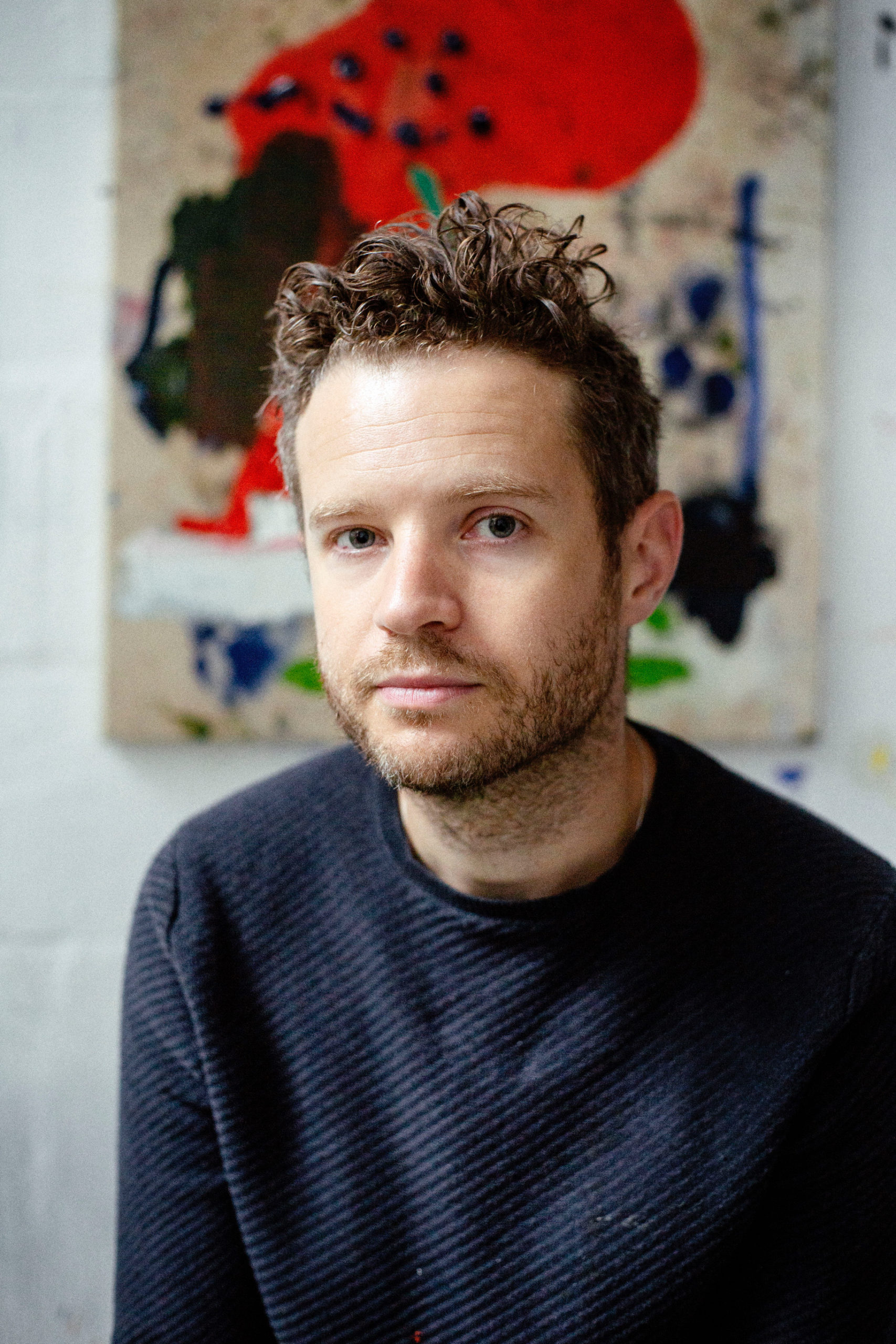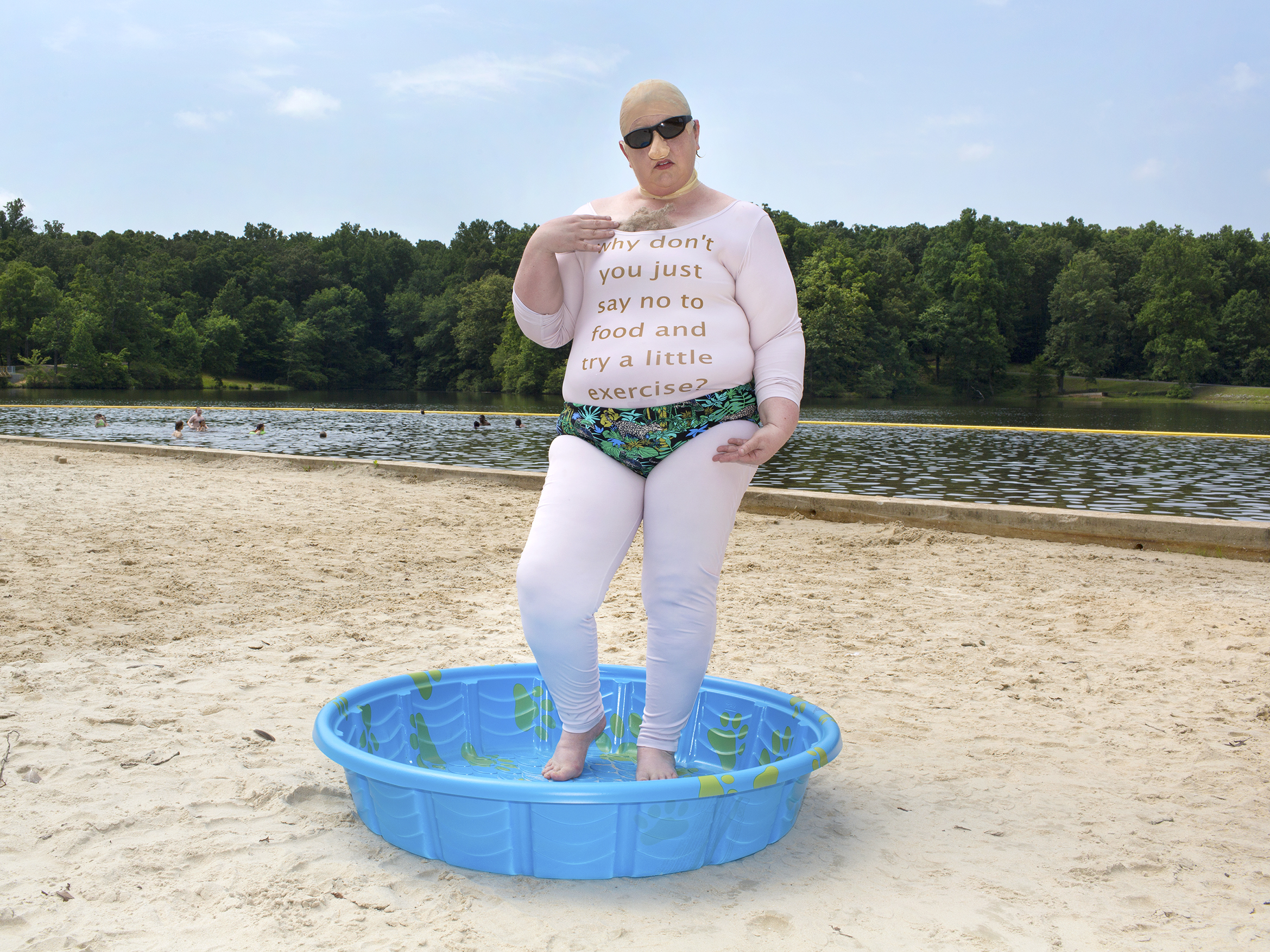
Portrait of artist Tim Garwood by James Frederick Barrett
Is it me, or are artists looking really good these days? Almost too good? The mythological image of the artist is rooted in the artist portrait photograph, that familiar tableau of a paint-splattered figure with disheveled hair, brooding and intense in their messy studio, brushes and pots of paint abandoned on the floor, canvases in progress in the background, references torn from obscurity and tacked to the wall. This is how we want artists to be: the perfect representation of chaos and wantonness. If artists are obliged to participate in this performance, then it’s likely we’re all guilty of fuelling it; after all, audiences are insatiable when it comes to image consumption in the age of the internet.
But something has shifted of late: I have noticed more portrait photos of artists circulating, and more frequently, in gallery newsletters, on art fair websites and, of course, on Instagram. Which makes sense in an increasingly fast-paced and commercialised art world, where social interactions are ruled by the cult of everyone-as-celebrity propelled by social media. Whether chic or shabby, nonchalant or earnest, in turps-drenched overalls or designer drip, everyone expects artists to reveal themselves, to let us peer into their private worlds. As a consequence, these pictures have become ever-more carefully calculated and are paramount to creating an artist’s ‘brand’.
An artist’s portrait speaks volumes about their work. And for those places—fairs, galleries, museums—associating with an artist’s work, the portrait photo is a way to make a direct statement about the people they want to support. “People should feel like they can understand who the artist is from their portrait, and connect with the work more through it; especially in these times it’s important for an artist to present themselves to their audience online when people can’t see the physical work”, says Hannah Watson, director of TJ Boulting. “But it can be ruined by trying too hard. So be yourself.”
“People should feel like they can understand who the artist is from their portrait, and connect with the work more through it”
Gallery-owner Sim Smith agrees. “Generally, collectors like to connect with an artist. Traditionally they may meet at a private view or some at studio visits but now things are so different with social media—everything moves much quicker and proximity is a given”, she tells me. “People like to see faces and to see people, it’s about connection. We have portraits on our website for this reason; it helps to tell a story and to make an artist recognisable. Some are in their studios, others are mid performance; it’s just important that the portrait is true to them. They have to feel comfortable and it has to be real, otherwise what is it for?”
Visibility constitutes a certain kind of power nowadays, but a portrait photo might, contrary to what you might think, serve another purpose—one that isn’t simply transactional. “A portrait photograph confirms and formalises the visibility of the artist. It shows us that art isn’t a product, service or an asset class but the considered, often solitary and radical act of another human being; a memento for a world where unseen labour and urgent consumption seem to be the present order of the day,” suggests Khuroum Bukhari, a writer and cultural strategist who works closely with artists, commercial galleries and public institutions.
Portrait photographs might be deployed in different ways to various ends, but what happens if you aren’t comfortable being photographed? Tim Garwood, a painter who is represented by Sim Smith, doesn’t feel confident getting in front of the camera. However, he explains, “I think showing people who you are is a part of standing alongside your work. In the same way the paintings are visible, the artist must also be visible too to allow people to get a more complete impression of the work, which is inextricably linked with the artist themselves.” He adds, “It shows a commitment and belief in what you are doing, even though I hate having my photo taken. Ultimately it is far more personal to share paintings than an image of yourself.”

Artist Emma Stern, who is based in Brooklyn and works with 3D software, sees her creative practice as intertwined directly with her own image. It therefore makes sense to present herself with her works. “I have always felt that there is some significance to these photos of myself. Part of this is certainly because my work deals directly with portraits of young women, or more specifically with avatars that I create, which I have come to regard ultimately as a kind of extended self-portraiture. I don’t necessarily mean this in a literal sense, but I do acknowledge that somewhere along the way I have started to look like my paintings, or maybe they have started to look like me.”
“Either way, there is some reflexive dynamic at play between myself and my work. Sometimes I will deliberately mimic the pose or outfit or palette of one of my subjects, but sometimes it’s more of a general vibe I am emulating. I am thinking specifically of one image where I’m in front of my painting called Jess, in which I’m crawling on the ground with platform shoes on my hands, emulating the pose of the figure in the painting.”
These portraits end up in the press, on her gallery’s website and in mailouts, as well as on the artist’s own media. “I really enjoy blurring the lines not only between art and artist, but between virtual and actual, especially because I deal directly with virtual female bodies in my work. In another widely circulated image, I am sitting on the bubblegum pink couch in my studio next to a life-sized body pillow with a cartoon avatar portrait of myself printed on it.”
“I do acknowledge that somewhere along the way I have started to look like my paintings, or maybe they have started to look like me”
Looking at Stern’s aforementioned portrait with the shoes, she conveys an unshakeable confidence; a young woman claiming the gaze, owning it—but it turns out that might be a bit of an act. “I am generally uncomfortable performing in the traditional sense and avoid live audiences, so turning myself into an avatar, or having my virtual self act as a surrogate for my actual self, has allowed me to cultivate a performative aspect to my practice that I may not have otherwise pursued.” Stern’s portrait is more off-the-wall than most; a touch irreverent, a little fetishistic. In a world when women in particular are used to the expectations of marketing their image, it is better to take control?
So what makes a good artist portrait? “It should be preferably shot in the artist’s own studio or in close proximity to their work”, Khuroum Bukhari suggests. Watson concurs. “Everyone loves seeing an artist in their studio as usually that’s where the magic happens”. But don’t go overboard: “It would be remiss to overstate its importance, it should be used sparingly and ideally in complement. After all, people should ultimately remember the work of an artist, not necessarily their person,” Bukhari adds. “Artists should throw their attention to it when and if they have to but also forget about it. I feel it remains superfluous to the making of great visual art but useful perhaps for its description and legacy.”

That may be so, it is undoubtedly easier easier to put yourself out there if you fit the mould. In a perpetually ageist, able-ist, sexist and racist image culture, publishing your personal image in any context makes you vulnerable. Haley Morris-Cafiero understands this only too well, and focuses on these issues in her work. She is represented by TJ Boulting but she hasn’t shot a portrait photograph as an artist, although she appears in all of her artwork in various guises. “Galleries don’t ask me for a profile photo because commercial galleries have not been interested in representing my work”, Morris-Cafiero says. “I am an activist and provocateur and am interested in creating social change. This can often make people uncomfortable as my work takes some of society’s prejudices and displays for all to see.”
Portrait photos might be a prerequisite for most artists, but there is something more than a little sinister about the demand to look a certain way, as if creating the art isn’t enough. But it doesn’t look like things will be changing any time soon. An email lands in my inbox from a commercial gallery: included in it are reams of artist portraits, advertising their forthcoming exhibitions. They’re dressed to match the palettes of their works in the background; a pale-pink boilersuit here, a pristine white shirt with sleeves rolled up there; not a paint-smattered outfit in sight.





